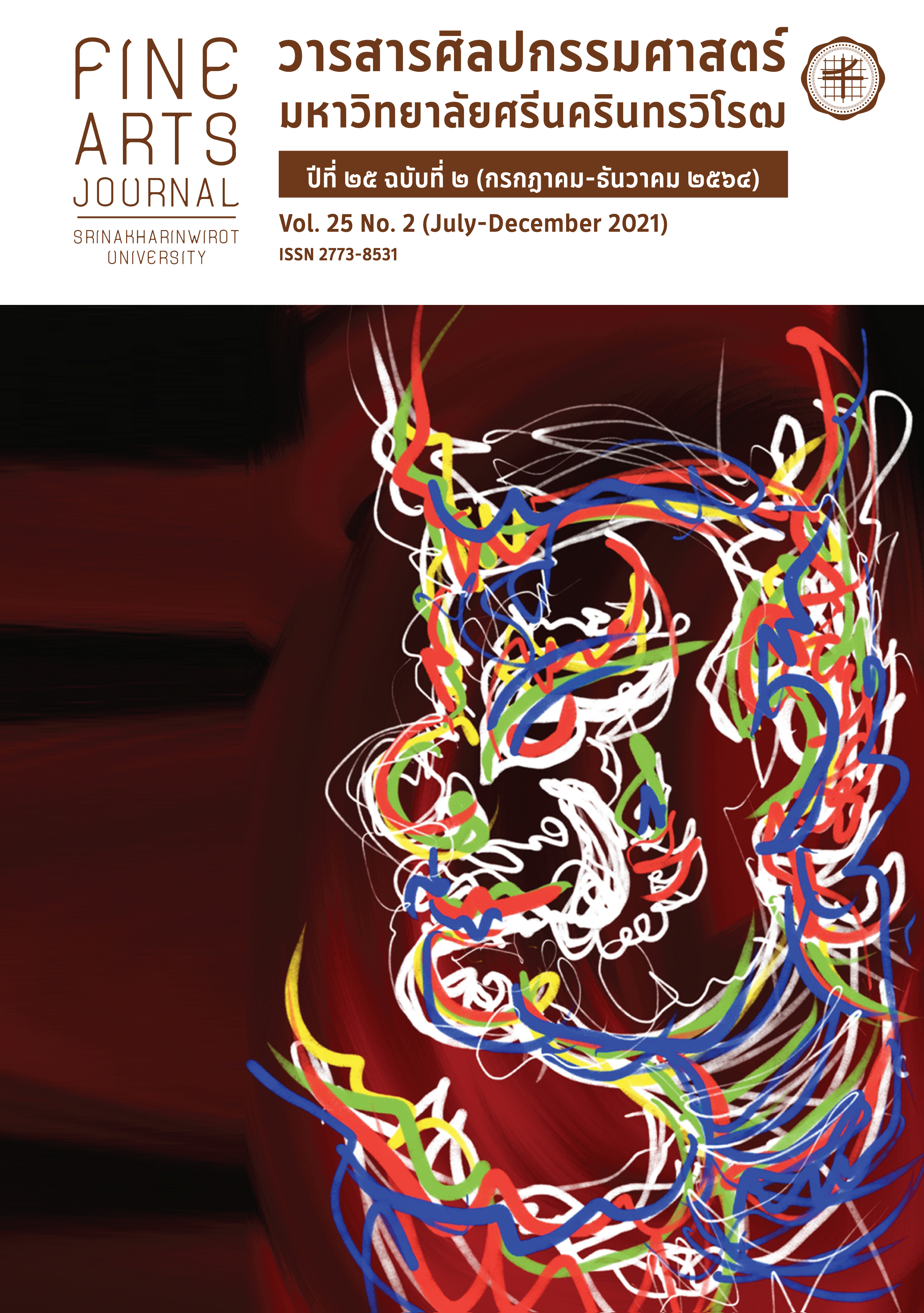DEVELOPMENT OF INTEGRATED ART ACTIVITY BETWEEN VISUAL ARTS AND STREET PERFORMING ARTS TO ENHANCE AESTHETIC PERCEPTIONS AMONG WORKING-AGE GROUP
Keywords:
Aesthetic perception, Visual arts, Street performing arts, Integrated art activityAbstract
The objectives of this research are 1) to study how aesthetic perceptions originated from integrated art activity between visual arts and street performing arts, and 2) to develop integrated art activity between visual arts and street performing arts to enhance aesthetic perceptions. The sample groups are working-age group, specialists of visual arts, specialists of performing arts and professional performers. The research instruments consist of the semi-structured interview, the evaluation form of aesthetic enhancement, the observation form of the participants while participating in the integrated art activity between visual arts and street performing arts. The data were analyzed qualitatively using analytic induction and content analysis.
The results of research show that the integration of visual arts and street performing arts share the similarities in creative process and aesthetic elements which consist of 8 main components (i.e. line, color, shape, space, repetition, harmony, contrast, and pattern). In terms of the development of the integrated art activity to enhance the aesthetic perceptions, there are 4 main components including 1) the attractive content which is easy to understand or related to everyday activities such as news, politic, basic needs, and comedy, 2) form of performance which is specifically designed by applying the movement of street performing arts, 3) costumes, and 4) the design of 5 levels of aesthetic perception enhancement. The activity takes 15 minutes and it is flexible in terms of the venue because the activity could be held either in a closed area like in the building or in an open area such as on the street and in the park.
Downloads
References
กำจร สุนพงษ์ศรี. (2559). สุนทรียศาสตร์ หลักปรัชญาศิลปะ ทฤษฎีทัศนศิลป์ ศิลปวิจารณ์ (พิมพ์ครั้งที่ 3).
กรุงเทพมหานคร: สำนักพิมพ์แห่งจุฬาลงกรณ์มหาวิทยาลัย.
ธาริน กลิ่นเกษร. (2554). ผลของการส่งเสริมประสบการณ์ทางสุนทรียะผ่านกิจกรรมในพิพิธภัณฑ์ศิลปะที่มีต่อ
สุนทรียภาพของนักเรียนประถมศึกษา (วิทยานิพนธ์ปริญญามหาบัณฑิต). จุฬาลงกรณ์มหาวิทยาลัย,
กรุงเทพมหานคร.
นราพงษ์ จรัสศรี. (2559). ประวัตินาฏยศิลป์ตะวันตก (พิมพ์ครั้งที่ 2). กรุงเทพมหานคร: สำนักพิมพ์แห่ง
จุฬาลงกรณ์มหาวิทยาลัย.
ปุณณรัตน์ พิชญไพบูลย์. (2559). เอกสารประกอบการสอน วิชา สุนทรียศาสตร์ในศิลปศึกษา. คณะครุศาสตร์
จุฬาลงกรณ์มหาวิทยาลัย.
พลศึกษา กระทรวงการท่องเที่ยวและกีฬา, กรม. (2557). คู่มือผู้นำนันทนาการ (พิมพ์ครั้งที่ 2). กรุงเทพมหานคร:
องค์การสงเคราะห์ทหารผ่านศึกในพระบรมราชูปถัมภ์.
วิรุณ ตั้งเจริญ. (2547). ศิลปะหลังสมัยใหม่. กรุงเทพมหานคร: อีแอนด์ไอคิว.
สำนักงานกองทุนสนับสนุนการสร้างเสริมสุขภาพ. (2558). วัยแรงงานมีสภาวะเครียด. สืบค้นเมื่อ 18 ตุลาคม 2563 จาก
สำนักงานสถิติแห่งชาติ กระทรวงดิจิทัลเพื่อเศรษฐกิจและสังคม. (2559). สรุปผลการสำรวจภาวะการทำงานของประชากร.
กรุงเทพมหานคร: กองสถิติสังคม.
สุขภาพจิต, กรม. (2559). กรมสุขภาพจิต ชวนวัยทำงาน คลายเครียด พักสมองใช้ “สติ” สร้างสุขที่ยั่งยืน. สืบค้นเมื่อ 7 ตุลาคม 2563
จาก http://www.forums.dmh.go.th/index.php?topic=138805.0
สุชาติ เถาทอง. (2536). หลักการทัศนศิลป์. กรุงเทพมหานคร: อักษรการพิมพ์.
สุชาติ สุทธิ. (2543). สุนทรียภาพของชีวิต. กรุงเทพมหานคร: เสมาธรรม.
อิทธิพล ตั้งโฉลก. (2550). แนวทางการสอนและสร้างสรรค์จิตรกรรมขั้นสูง. กรุงเทพมหานคร: อมรินทร์พริ้นติ้ง.
Adams, W. (1999). Aesthetics: Liberating the senses. In T. Carver (Ed.), The cambridge
companion to Marx (pp. 246-274). USA: Cambridge University Press.
Austring, B.D., & Sørensen, M.C. (2011). Aesthetics and learning. International conference: The future of
education (volume 2). Retreived October 4, 2020, from
https://www.researchgate.net/publication/236172876_Aesthetics_and_Learning
Cohen, D., & Greenwood, B. (1981). Buskers: History of street entertainment. USA: Devid
& Charles.
Locher, P. (2011). Contemporary experimental aesthetics: State of the art technology.
I-Perception, 697–707. Retreived October 4, 2020, from
https://doi.org/10.1068/i0449aap
Mason, B. (1992). Street theatre and other outdoor performance. London: Routledge.
Mockros, C.A. (1993). The development of aesthetic experience and judgement. Poetics, 21(5),
-427. Retreived October 4, 2020, from
https://www.sciencedirect.com/science/article/abs/pii/0304422X9390003Y
Polster, B. (2003). The mathematics of juggling. New York: Springer.
Romero, J. (1996). Intergrating visual and performing art into social studies (Master thesis). California State
University, USA.
Shimamura, P.A., & Palmer, E.S. (2012). Aesthetic science. New York: Oxford University Press.
Tennessen, C.M. (1995). Views to nature: Effects on attention. Journal of Environmental
Phycology, 15(1), 77-85.






